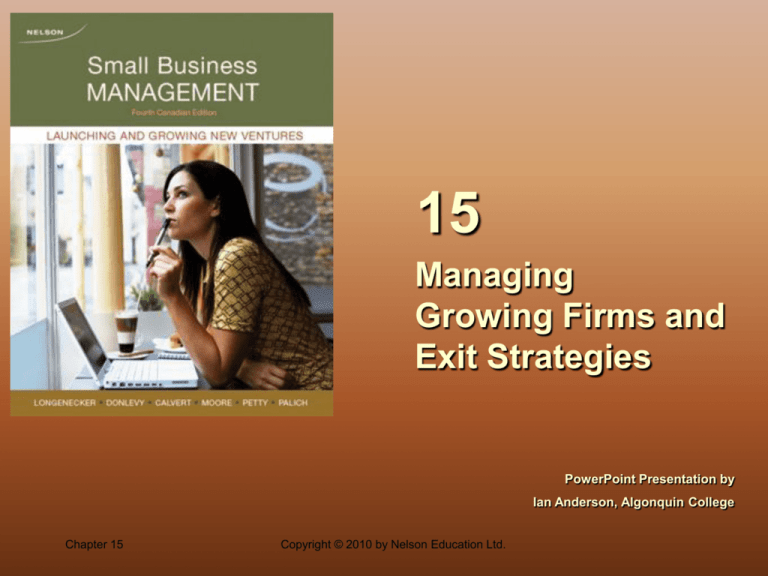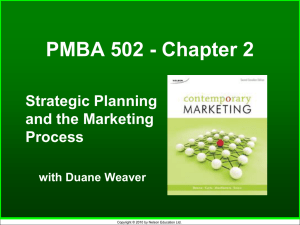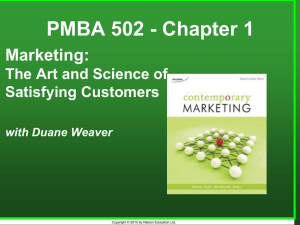Exiting: Selling the Firm - Launching and Growing New Ventures
advertisement

15 Managing Growing Firms and Exit Strategies PowerPoint Presentation by Ian Anderson, Algonquin College Chapter 15 Copyright © 2010 by Nelson Education Ltd. Looking Ahead After studying this chapter, you should be able to: 1. Describe managing for growth. 2. Explain the various types of outside management assistance. 3. Explain the importance of having an exit strategy. 4. Describe succession planning. 5. Discuss serial entrepreneurs. 6. Describe harvesting options and effective harvesting strategies. 7. Discuss issues in preparing for life after the harvest. Chapter 15 Copyright © 2010 by Nelson Education Ltd. 15-2 Managing for Growth • Many SMEs fail to achieve commercial success Queen's School of Business study: • – – – Chapter 15 lack organizational and leadership skills fail to plan for and manage growth fail to implement plans Copyright © 2010 by Nelson Education Ltd. 15-3 Achieving Sustainability • • • • • • • • • Annual planning process Anticipate growth challenges Change course and direction if required Groom leadership Step back to get a broader perspective Professional advice between stages Best practices Promote, communicate, and manage change Promote discussion Chapter 15 Copyright © 2010 by Nelson Education Ltd. 15-4 Outside Management Assistance Business Incubators Counselling Assistance to Small Enterprise (CASE) Other Business and Professional Services Outside Management Assistance Entrepreneurial Networks Management Consultants Chapter 15 Canadian Youth Business Foundation (CYBF) Industry Canada Industrial Research Assistance Program (IRAP) Copyright © 2010 by Nelson Education Ltd. 15-5 Low-Cost Space Services Provided by Business Incubators to New Firms Credibility Management Counsel Links to Accounting, Legal, Other Professional Services Business Incubator Access to Financial Resources Entrepreneurial Education Photocopying, Receptionist, Photocopying, Receptionist, Word-Processing Servicesand Computer Services Practical Business Expertise Chapter 15 Copyright © 2010 by Nelson Education Ltd. Exhibit 15-1 15-6 The Importance of the Harvest • Harvesting (or exiting) –The process used by entrepreneurs and investors to reap the value of a business when they get out of it. –The process involves: • Capturing value (cash value) • Reducing risk • Creating future options Chapter 15 Copyright © 2010 by Nelson Education Ltd. 15-7 Succession Planning • Pass to next generation or • Hire managers to reduce personal involvement • A written succession plan will address: – – – – – – Chapter 15 Identify future managers and leaders How to assess potential candidates Monitoring process Training and declaration of a successor Timeline Operational and tax issues Copyright © 2010 by Nelson Education Ltd. 15-8 Serial Entrepreneurs • Innovative and creative people who are more interested in starting new businesses than running them • Characteristics: – – – – Chapter 15 Determination Commitment Perseverance Vision Copyright © 2010 by Nelson Education Ltd. 15-9 Methods of Harvesting Exit Options Selling the Firm Releasing Cash Flows Going Public Using Private Equity Liquidation Strategic Acquisition Chapter 15 Financial Acquisition: LBO or MBO Employee Acquisition Copyright © 2010 by Nelson Education Ltd. 15-10 Exiting: Selling the Firm • Buyers’ reasons for purchasing a firm: –Strategic acquisition • Synergies to be gained in combination with other assets –Financial acquisition • Profitability of the firm as a stand-alone business –Employee acquisition • Preservation of employment for current employees …continued Chapter 15 Copyright © 2010 by Nelson Education Ltd. 15-11 Exiting: Selling the Firm • Strategic Acquisition –A purchase in which the value of the business is based on both the firm’s stand-alone characteristics and synergies that the buyer thinks can be created by the strategic fit of the firm and a potential buyer. …continued Chapter 15 Copyright © 2010 by Nelson Education Ltd. 15-12 Exiting: Selling the Firm • Financial Acquisition – A purchase in which the value of the business is based on the standalone cash generating potential of the firm being acquired. • Leveraged Buyout (LBO) – A purchase heavily financed with debt, when the potential cash flow of the target company is expected to be sufficient to meet debt repayments. • Bust-up LBO—purchasing with the intention of selling off assets • Build-up LBO—purchasing similar firms to make one larger company …continued Chapter 15 Copyright © 2010 by Nelson Education Ltd. 15-13 Exiting: Selling the Firm • Management Buyout (MBO) – A leveraged buyout that includes the firm’s top management to significant shareholders in the acquired firm. Chapter 15 Copyright © 2010 by Nelson Education Ltd. 15-14 Employee Ownership Plan • Employee Ownership –A method by which a firm is sold either in part or in total to its employees. –Frequently is the exit method of last resort. –Motivates the employeeowners to perform. Chapter 15 Copyright © 2010 by Nelson Education Ltd. 15-15 Releasing the Firm’s Cash Flows • Exiting by Withdrawing Firm’s Cash –Advantages: • Retain control of firm while harvesting investment. • No need to seek a buyer or incur expenses associated with sale of business –Disadvantages • Loss of development potential and opportunities • Tax disadvantages of cash withdrawal • Requires patience to siphon off cash slowly Chapter 15 Copyright © 2010 by Nelson Education Ltd. 15-16 Going Public •Initial Public Offering (IPO) – The first sale of shares of a company’s stock to the public in order to: • raise capital to repay outstanding debt • strengthen the balance sheet to support growth • create a source of capital that can be selectively accessed to fund continuing growth • create a liquid currency to fund future acquisitions • create a liquid market for the company’s stock • broaden the shareholder base • create ongoing interest in the company and its continued development Source: Lisa D. Stein, vice-president, Salomon Smith Barney. Chapter 15 Copyright © 2010 by Nelson Education Ltd. 15-17 Using Private Equity • Private Equity (Capital) –Money provided by venture capitalists or private investors. • Factors in the Transfer of Family-Owned Firms –Liquidity for exiting family members –Continued financing for company growth –Maintenance of family control of the firm Chapter 15 Copyright © 2010 by Nelson Education Ltd. 15-18 Illustration of Private Equity Placement Exhibit 15-2 Chapter 15 Copyright © 2010 by Nelson Education Ltd. 15-19 Liquidation • Founder manager would not typically choose to liquidate as the harvest value will be less. • Some businesses such as one person consulting firms cannot operate without the owner and therefore have limited value to potential buyers. • Other firms may not be attractive due to the deterioration of their customer base, leveraged financial positions, or aging and unproductive equipment. Chapter 15 Copyright © 2010 by Nelson Education Ltd. 15-20 Firm Valuation and the Exit • The Actual Value –Opportunity cost of funds • The rate of return that could be earned on another investment of similar risk • Harvest Value/Market Comparable Valuation –Establishing the value of a privately held company based on the value of a similar or comparable publicly traded company. Chapter 15 Copyright © 2010 by Nelson Education Ltd. 15-21 Developing an Effective Exit Strategy • Understand What You Want –Motives for exiting • • • • • Money Independence Health of the company Your management team An heir apparent taking over –Personal identity and the business itself –Avoid “seller’s remorse” Chapter 15 Copyright © 2010 by Nelson Education Ltd. 15-22 Life After the Harvest Two key questions must be asked by the exiting entrepreneur. 1.Will I experience serious regrets over the decision to harvest my investment in a company? 2.What will become my passion after I have become more than contended with the “easy life” where I have the option to play golf every day if I choose or to travel to my heart’s content? Chapter 15 Copyright © 2010 by Nelson Education Ltd. 15-23







